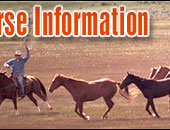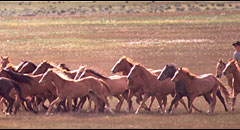 |
   |
|
|
|
You are here: Horses > Horse nutrition / feed > Winter Horse Feeding |
Horse Need Different Feed Diets in Winter’s Cold Weather
When the weather turns chilly, we all think of rich, warming
foods—hearty stews, meaty chili, and warm, freshly baked
cookies. But the changing weather should also remind us that
our horses have winter needs, too. |
|
|
A horse’s dietary needs change with the colder weather. Many
horse owners instinctively adjust the amount and type of
feed they offer, without fully researching the science
behind it. Common practices of adding extra corn, vegetable
oil, grain, or hay to increase a horse’s caloric intake,
however, can cause different concerns. Top-dressing with
corn, which is often thought to have a warming effect, can
increase the risk of colic. Extra vegetable oil or hay can
alter the vitamin and mineral balance of the horse’s diet
and adding extra grain can raise a horse’s grain intake to
an unhealthy level. |
 A better method for winter feeding of hard-keeper horses can
be to switch to a different feed blend with a higher fat
guarantee. While a standard, basic feed will usually contain
around 2.5% fat, other blends are available with fat
contents from 4.5% to 8%. For especially cold climates or
horses with other special needs, there are feed blends with
up to 10% fat content. These higher-fat options provide a
horse with the extra energy it needs to thrive through the
winter. A better method for winter feeding of hard-keeper horses can
be to switch to a different feed blend with a higher fat
guarantee. While a standard, basic feed will usually contain
around 2.5% fat, other blends are available with fat
contents from 4.5% to 8%. For especially cold climates or
horses with other special needs, there are feed blends with
up to 10% fat content. These higher-fat options provide a
horse with the extra energy it needs to thrive through the
winter.
Another option is supplementation with rice bran. By adding
just one pound of rice bran a day, most horses will receive
the extra calories they need. Two fifty-pound bags can last
the entire winter, which also makes it economical. Most
experts recommend beginning rice bran supplementation two to
three weeks before the cold weather starts.
While adding additional hay is a common way to help horses
through the winter, it can become expensive and deplete hay
stores more rapidly than desired. Other forms of fiber
supplementation can provide the fiber horses need.
Two sources of fiber that are not ideal, however, are
alfalfa and beet pulp. Alfalfa fibers are too short to be an
optimal fiber replacement. Beet pulp can be labor intensive,
requiring soaking before feeding, and it lacks the necessary
nutrients horses need. To improve fiber intake, alfalfa
cubes (or cubes combining alfalfa with timothy) can be
effective. Horses usually require approximately four to five
pounds of alfalfa cubes daily or a similar amount of chopped
forage for owners who don’t wish to feed their equines
cubes.
Another good “fiber solution” is to utilize a complete feed.
Complete feeds are formulated to meet all of a horse’s
dietary and fiber needs in one blend, without additional hay
or grain. They typically consist of an alfalfa or beet pulp
base blended with vitamins, minerals, and grains, and work
very well to extend hay supplies or as an alternative energy
supplement to grains. However, most experts recommend that
horses are occasionally given hay to increase their
long-fiber intake, rather that totally relying on the feed.
There are a variety of complete feeds available today, but
most are relatively low-energy blends. There are some newer
brands, however, that offer higher energy value. Some feeds
blend beet pulp and additional fat to make a complete feed
that yields as much energy as many grain-based performance
feeds. Another expanding segment of the complete feed market
is the complete cube. Several brands are now designed
specifically for maintenance and performance, and some
specialize in nutrition for mares and foals. There are
complete cube products that combine western alfalfa,
timothy, high-quality grains, organic minerals, fat, and
vitamins for a high-quality blend.
Also, remember that older horses have additional needs
during the winter. Starting them on a specially designed
geriatric diet in the fall, such as a high-fat, beet-pulp
based feed can help them maintain weight during frigid
weather. Look for one with a fat level of 7% or more, as it
will provide the extra calories needed to keep older horses
from losing weight during the winter.
When it is cold, horses will naturally spend more time
inside their stalls. This leads to the need for increased
odor control to prevent ammonia levels from becoming harmful
to horses. Ammonia neutralizing products can greatly help to
prevent ammonia-related respiratory issues caused by stall
confinement.
And finally, remember that plenty of fresh water needs to be
available to horses at all times. Keeping the water in the
45-to-65 degree range will make sure that it is not too cold
to drink.

|
Read the next horse nutrition article on Feeding Your Horse In Colder Weather. |
|
|
|
|
 |
|
|
|
|
|
Horse Education
|
|
|
|
|
Horse Information Topics
|
|
|
|
|
|
|
|
Horse Business Owners
|
| |
Advertise with Us
Have your horse products or services exposed to over 27,000 of our monthly visitors.
|
|
|
|
|
|